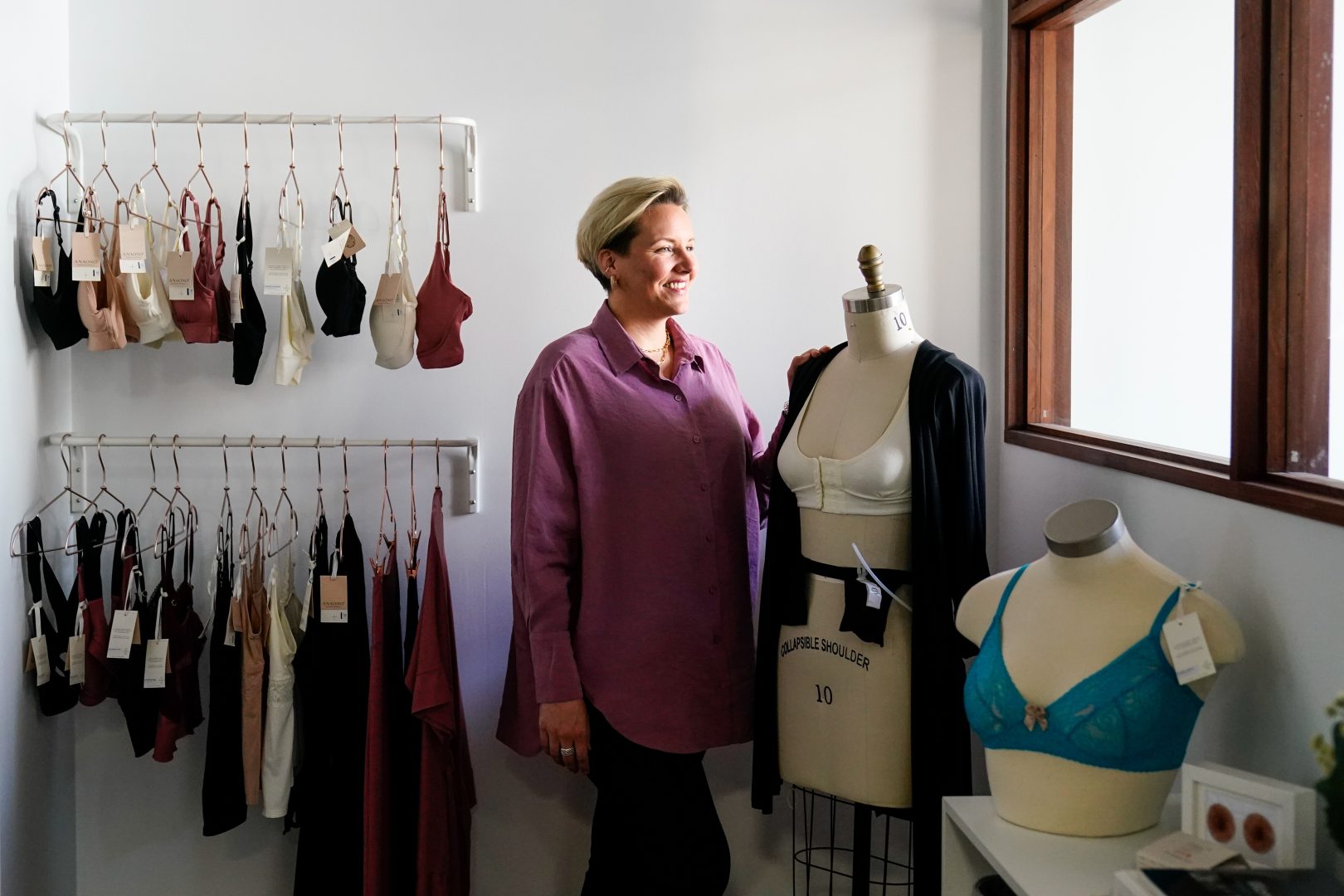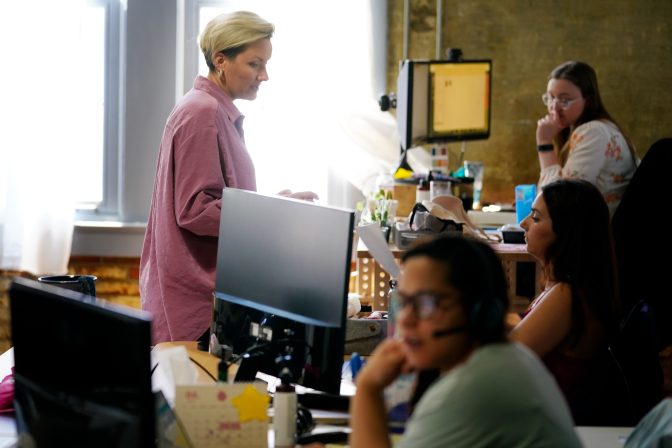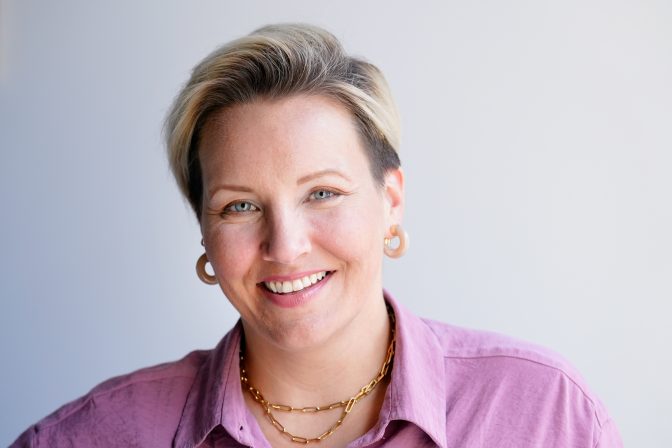
AnaOno founder and CEO, Dana Donofree, poses for a portrait in Philadelphia, Friday, April 22, 2022. (AP Photo/Matt Rourke)

AnaOno founder and CEO, Dana Donofree, poses for a portrait in Philadelphia, Friday, April 22, 2022. (AP Photo/Matt Rourke)

AnaOno founder and CEO, Dana Donofree, poses for a portrait in Philadelphia, Friday, April 22, 2022. (AP Photo/Matt Rourke)
When Dana Donofree had a bilateral mastectomy and implant reconstruction after her breast cancer diagnosis in 2010, the then 27-year-old fashion designer discovered only medical and uncomfortable bras catering to women with the disease.
Such frustrations led Donofree to launch her lingerie company called AnaOno in 2014, aimed primarily for women who had breast cancer and had undergone some type of surgery. The Philadelphia-based company now offers a variety of wireless bras for women who had breast reconstruction, a mastectomy or lumpectomy because Donofree says every surgery yields different results. The collection also includes post-surgery loungewear.

AnaOno founder and CEO, Dana Donofree, speaks with her staff in Philadelphia, Friday, April 22, 2022. (AP Photo/Matt Rourke)
While the designs were initially sold on her website and medical supply stores, AnaOno is found at mainstream online shops including Soma, ThirdLove, and more recently Nordstrom and soon Target.com. Her designs are also sold overseas in such countries as Spain, Israel and Canada. Her products incorporate four-way stretch, hidden seams, and gentle fabrics like imported modal, which don’t rub against scars. Other brands like Athleta now offer mastecdomy bras, but Donofree said overall the selection is still limited.
Donofree, who has sat on various breast cancer nonprofit boards, is also breaking taboos about women and breast cancer. She has helped to embolden the breast cancer community, using breast cancer survivors of all shapes and ethnicities in her campaigns. Her runway events, which went on hiatus during the pandemic, have raised over $500,000 for metastatic breast cancer research.
Donofree is one of a number of breast cancer survivors creating their own products from beauty items to trendy headwraps to help others, says Melissa Berry, founder of Cancer Fashionista, an online resource offering beauty, fashion and lifestyle tips for women being treated for breast cancer and beyond. AnaOno expects to have 30,000 customers and nearly $3 million in revenue this year, nearly double last year’s numbers. Donofree says her goal is to reach 100,000 women and plans to expand into swimwear next season.
AP recently interviewed Donofree about how she’s filling the gap in lingerie for breast cancer survivors and how she’s advocating for the breast cancer community. The interview has been edited for clarity and length.

AnaOno founder and CEO, Dana Donofree, poses for a portrait in Philadelphia, Friday, April 22, 2022. (AP Photo/Matt Rourke)
Q. What were the type of bras being offered to breast cancer survivors before you started AnaOno?
A. Matronly, utilitarian … the quintessential grandma bra. So when there’s bedpans and wheelchairs, there was also your mastectomy bras and being a young woman who had just completely removed all of her breast tissue, including my nipples, it was just a very jarring experience that felt like the world was telling me that I was no longer allowed to act or look like a woman, that something inside of me was now broken. But this isn’t normal.
Q. What’s the design process?
A. AnaOno is boob inclusive. So if it’s two boobs, one boob, no boobs or new boobs, we have you supported. And the way that we’re able to do that is by modifying the design and the practicality of what a bra is meant to do. So I removed the underwire. I removed the sort of traditional cup design to a bra. So everything we have is multiple stretch, multiple different directions. We use that incredible, beautiful modal material, which is not typical for bra design.
Q. What was the initial reaction from stores?
A. Every time I went out and I traveled, I would look up all of the specialty lingerie stores in that city, and I would look up all of the plastic surgeons specializing in breast cancer reconstruction. And the reason was because I had to put my feet on the ground. I had to go boots on the ground, knock on doors, give my sales pitch. And in doing that, getting exposed to not just stores and specialty boutiques and plastic surgeons and medical practices, I realized just how disjointed the conversation was about what sort of surgeries we were having and what they were doing to our bodies and then what the solutions were on the other side.
Q. What was your breakthrough moment?
A. We had an opportunity to go on a global stage at New York Fashion Week (in 2017). You could see what a body looked like without breasts, or you could see what a body look like without nipples, because this was that harsh reality that people just didn’t understand unless you had been through it. And using art and fashion and conversation and advocacy all together really helped to propel a different sort of conversation. We can show the world what cancer really looks like. And that was a pivotal moment where we started changing the conversation.
Q. What kind of progress has the lingerie industry made in catering to breast cancer survivors?
A. I think there’s been a big shift in our movement, especially in the last decade. We stepped out as one of the first lingerie brands using real people and bras and underwear. It’s probably the hardest thing to showcase in a model. I think what we’re still missing is absolute inclusion now. The reality is … 1 in 8 women are diagnosed with breast cancer in their lifetime. This is a substantial amount of people that don’t have breasts or might only have one breast or have rebuilt their breast.

A collection of interviews, photos, and music videos, featuring local musicians who have stopped by the WITF performance studio to share a little discussion and sound. Produced by WITF’s Joe Ulrich.
The days of journalism’s one-way street of simply producing stories for the public have long been over. Now, it’s time to find better ways to interact with you and ensure we meet your high standards of what a credible media organization should be.